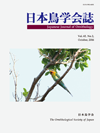Volume 65, Issue 2
Displaying 1-12 of 12 articles from this issue
- |<
- <
- 1
- >
- >|
REVIEWS
-
2016Volume 65Issue 2 Pages 105-128
Published: 2016
Released on J-STAGE: November 22, 2016
Download PDF (652K)
ARTICLES
-
2016Volume 65Issue 2 Pages 129-142
Published: 2016
Released on J-STAGE: November 22, 2016
Download PDF (1103K) -
2016Volume 65Issue 2 Pages 143-152
Published: 2016
Released on J-STAGE: November 22, 2016
Download PDF (708K)
SHORT NOTES
-
2016Volume 65Issue 2 Pages 153-160
Published: 2016
Released on J-STAGE: November 22, 2016
Download PDF (629K) -
2016Volume 65Issue 2 Pages 161-166
Published: 2016
Released on J-STAGE: November 22, 2016
Download PDF (712K)
OBSERVATIONAL DATA
-
2016Volume 65Issue 2 Pages 167-172
Published: 2016
Released on J-STAGE: November 22, 2016
Download PDF (782K) -
2016Volume 65Issue 2 Pages 173-176
Published: 2016
Released on J-STAGE: November 22, 2016
Download PDF (701K) -
2016Volume 65Issue 2 Pages 177-180
Published: 2016
Released on J-STAGE: November 22, 2016
Download PDF (617K) -
2016Volume 65Issue 2 Pages 181-185
Published: 2016
Released on J-STAGE: November 22, 2016
Download PDF (614K) -
2016Volume 65Issue 2 Pages 187-191
Published: 2016
Released on J-STAGE: November 22, 2016
Download PDF (836K)
OTHER ARTICLES
-
2016Volume 65Issue 2 Pages 192
Published: 2016
Released on J-STAGE: November 22, 2016
Download PDF (272K) -
2016Volume 65Issue 2 Pages 193-194
Published: 2016
Released on J-STAGE: November 22, 2016
Download PDF (605K)
- |<
- <
- 1
- >
- >|
